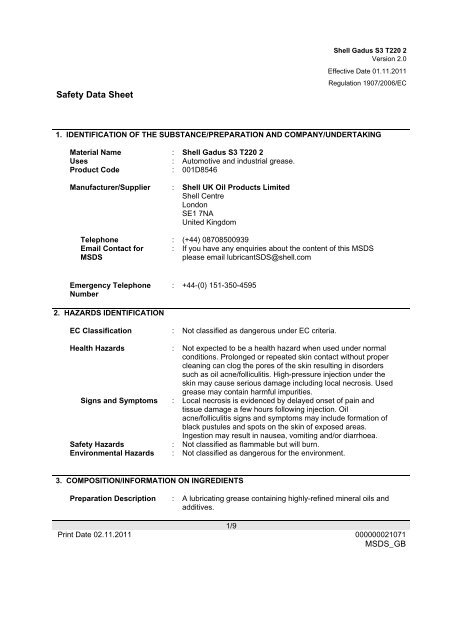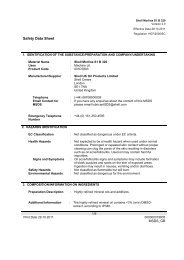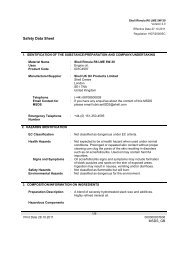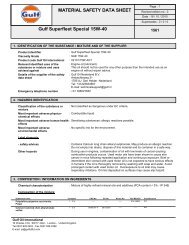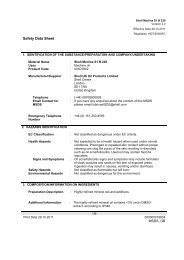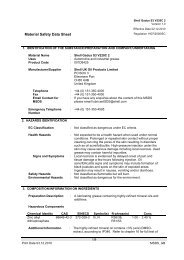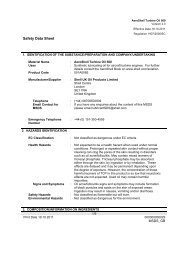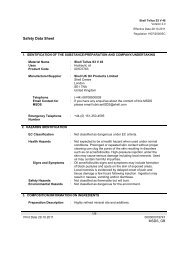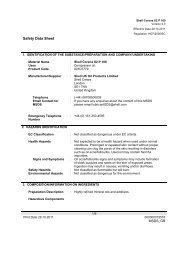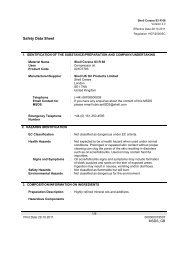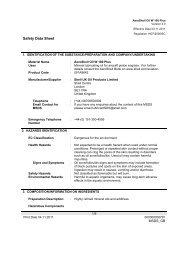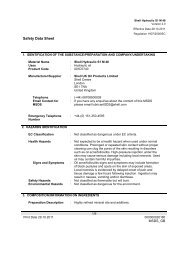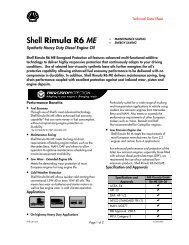GADUS S3 T220 2.pdf - Oils & Stuff
GADUS S3 T220 2.pdf - Oils & Stuff
GADUS S3 T220 2.pdf - Oils & Stuff
Create successful ePaper yourself
Turn your PDF publications into a flip-book with our unique Google optimized e-Paper software.
Safety Data Sheet<br />
Shell Gadus <strong>S3</strong> <strong>T220</strong> 2<br />
Version 2.0<br />
Effective Date 01.11.2011<br />
Regulation 1907/2006/EC<br />
1. IDENTIFICATION OF THE SUBSTANCE/PREPARATION AND COMPANY/UNDERTAKING<br />
Material Name : Shell Gadus <strong>S3</strong> <strong>T220</strong> 2<br />
Uses : Automotive and industrial grease.<br />
Product Code : 001D8546<br />
Manufacturer/Supplier : Shell UK Oil Products Limited<br />
Shell Centre<br />
London<br />
SE1 7NA<br />
United Kingdom<br />
Telephone : (+44) 08708500939<br />
Email Contact for : If you have any enquiries about the content of this MSDS<br />
MSDS<br />
please email lubricantSDS@shell.com<br />
Emergency Telephone<br />
Number<br />
: +44-(0) 151-350-4595<br />
2. HAZARDS IDENTIFICATION<br />
EC Classification : Not classified as dangerous under EC criteria.<br />
Health Hazards : Not expected to be a health hazard when used under normal<br />
conditions. Prolonged or repeated skin contact without proper<br />
cleaning can clog the pores of the skin resulting in disorders<br />
such as oil acne/folliculitis. High-pressure injection under the<br />
skin may cause serious damage including local necrosis. Used<br />
grease may contain harmful impurities.<br />
Signs and Symptoms : Local necrosis is evidenced by delayed onset of pain and<br />
tissue damage a few hours following injection. Oil<br />
acne/folliculitis signs and symptoms may include formation of<br />
black pustules and spots on the skin of exposed areas.<br />
Ingestion may result in nausea, vomiting and/or diarrhoea.<br />
Safety Hazards : Not classified as flammable but will burn.<br />
Environmental Hazards : Not classified as dangerous for the environment.<br />
3. COMPOSITION/INFORMATION ON INGREDIENTS<br />
Preparation Description : A lubricating grease containing highly-refined mineral oils and<br />
additives.<br />
1/9<br />
Print Date 02.11.2011 000000021071<br />
MSDS_GB
Safety Data Sheet<br />
Shell Gadus <strong>S3</strong> <strong>T220</strong> 2<br />
Version 2.0<br />
Effective Date 01.11.2011<br />
Regulation 1907/2006/EC<br />
Hazardous Components<br />
Chemical Name CAS No. EINECS REACH Symbol(s) R-phrase(s) Conc.<br />
Registration<br />
No.<br />
Triaryl<br />
phosphorothiona<br />
te<br />
597-82-0 209-909-9 R53 < 3.00%<br />
Additional Information : The highly refined mineral oil contains
Safety Data Sheet<br />
Shell Gadus <strong>S3</strong> <strong>T220</strong> 2<br />
Version 2.0<br />
Effective Date 01.11.2011<br />
Regulation 1907/2006/EC<br />
5. FIRE FIGHTING MEASURES<br />
Clear fire area of all non-emergency personnel.<br />
Specific Hazards : Hazardous combustion products may include: A complex<br />
mixture of airborne solid and liquid particulates and gases<br />
(smoke). Carbon monoxide. Unidentified organic and inorganic<br />
compounds.<br />
Suitable Extinguishing<br />
Media<br />
: Foam, water spray or fog. Dry chemical powder, carbon<br />
dioxide, sand or earth may be used for small fires only.<br />
Unsuitable Extinguishing : Do not use water in a jet.<br />
Media<br />
Protective Equipment for<br />
Firefighters<br />
6. ACCIDENTAL RELEASE MEASURES<br />
: Proper protective equipment including breathing apparatus<br />
must be worn when approaching a fire in a confined space.<br />
Avoid contact with spilled or released material. For guidance on selection of personal protective<br />
equipment see Chapter 8 of this Material Safety Data Sheet. See Chapter 13 for information on<br />
disposal. Observe the relevant local and international regulations.<br />
Protective measures : Avoid contact with skin and eyes. Use appropriate containment<br />
to avoid environmental contamination. Prevent from spreading<br />
or entering drains, ditches or rivers by using sand, earth, or<br />
other appropriate barriers.<br />
Clean Up Methods : Shovel into a suitable clearly marked container for disposal or<br />
reclamation in accordance with local regulations.<br />
7. HANDLING AND STORAGE<br />
General Precautions : Use local exhaust ventilation if there is risk of inhalation of<br />
vapours, mists or aerosols. Properly dispose of any<br />
contaminated rags or cleaning materials in order to prevent<br />
fires. Use the information in this data sheet as input to a risk<br />
assessment of local circumstances to help determine<br />
appropriate controls for safe handling, storage and disposal of<br />
this material.<br />
Handling : Avoid prolonged or repeated contact with skin. Avoid inhaling<br />
vapour and/or mists. When handling product in drums, safety<br />
footwear should be worn and proper handling equipment<br />
should be used.<br />
Storage : Keep container tightly closed and in a cool, well-ventilated<br />
3/9<br />
Print Date 02.11.2011 000000021071<br />
MSDS_GB
Safety Data Sheet<br />
Shell Gadus <strong>S3</strong> <strong>T220</strong> 2<br />
Version 2.0<br />
Effective Date 01.11.2011<br />
Regulation 1907/2006/EC<br />
place. Use properly labelled and closeable containers. Storage<br />
Temperature: 0 - 50°C / 32 - 122°F<br />
The storage of this product may be subject to the Control of<br />
Pollution (Oil Storage) (England) Regulations. Further<br />
guidance may be obtained from the local environmental<br />
agency office.<br />
Recommended Materials : For containers or container linings, use mild steel or high<br />
density polyethylene.<br />
Unsuitable Materials : PVC.<br />
Additional Information : Polyethylene containers should not be exposed to high<br />
temperatures because of possible risk of distortion.<br />
Exposure to this product should be reduced as low as<br />
reasonably practicable. Reference should be made to the<br />
Health and Safety Executive's publication "COSHH Essentials".<br />
8. EXPOSURE CONTROLS/PERSONAL PROTECTION<br />
If the American Conference of Governmental Industrial Hygienists (ACGIH) value is provided on<br />
this document, it is provided for information only.<br />
Occupational Exposure Limits<br />
Material Source Type ppm mg/m3 Notation<br />
Oil mist, mineral ACGIH TWA<br />
[Inhalable<br />
fraction.]<br />
5 mg/m3<br />
Additional Information : Due to the product's semi-solid consistency, generation of<br />
mists and dusts is unlikely to occur.<br />
Exposure Controls : The level of protection and types of controls necessary will vary<br />
depending upon potential exposure conditions. Select controls<br />
based on a risk assessment of local circumstances.<br />
Appropriate measures include: Adequate ventilation to control<br />
airborne concentrations. Where material is heated, sprayed or<br />
mist formed, there is greater potential for airborne<br />
concentrations to be generated.<br />
Personal Protective<br />
Equipment<br />
: Personal protective equipment (PPE) should meet<br />
recommended national standards. Check with PPE suppliers.<br />
Respiratory Protection : No respiratory protection is ordinarily required under normal<br />
conditions of use. In accordance with good industrial hygiene<br />
practices, precautions should be taken to avoid breathing of<br />
material. If engineering controls do not maintain airborne<br />
concentrations to a level which is adequate to protect worker<br />
4/9<br />
Print Date 02.11.2011 000000021071<br />
MSDS_GB
Safety Data Sheet<br />
Shell Gadus <strong>S3</strong> <strong>T220</strong> 2<br />
Version 2.0<br />
Effective Date 01.11.2011<br />
Regulation 1907/2006/EC<br />
health, select respiratory protection equipment suitable for the<br />
specific conditions of use and meeting relevant legislation.<br />
Check with respiratory protective equipment suppliers. Where<br />
air-filtering respirators are suitable, select an appropriate<br />
combination of mask and filter. Select a filter suitable for<br />
combined particulate/organic gases and vapours [boiling point<br />
>65 °C (149 °F)] meeting EN14387.<br />
Hand Protection : Where hand contact with the product may occur the use of<br />
gloves approved to relevant standards (e.g. Europe: EN374,<br />
US: F739) made from the following materials may provide<br />
suitable chemical protection: PVC, neoprene or nitrile rubber<br />
gloves. Suitability and durability of a glove is dependent on<br />
usage, e.g. frequency and duration of contact, chemical<br />
resistance of glove material, glove thickness, dexterity. Always<br />
seek advice from glove suppliers. Contaminated gloves should<br />
be replaced. Personal hygiene is a key element of effective<br />
hand care. Gloves must only be worn on clean hands. After<br />
using gloves, hands should be washed and dried thoroughly.<br />
Application of a non-perfumed moisturizer is recommended.<br />
Eye Protection : Wear safety glasses or full face shield if splashes are likely to<br />
occur. Approved to EU Standard EN166.<br />
Protective Clothing : Skin protection not ordinarily required beyond standard issue<br />
work clothes.<br />
Monitoring Methods : Monitoring of the concentration of substances in the breathing<br />
zone of workers or in the general workplace may be required to<br />
confirm compliance with an OEL and adequacy of exposure<br />
controls. For some substances biological monitoring may also<br />
be appropriate.<br />
Environmental Exposure<br />
Controls<br />
9. PHYSICAL AND CHEMICAL PROPERTIES<br />
: Minimise release to the environment. An environmental<br />
assessment must be made to ensure compliance with local<br />
environmental legislation.<br />
Appearance<br />
: Light brown. Semi-solid at room temperature.<br />
Odour<br />
: Slight hydrocarbon.<br />
pH<br />
: Not applicable.<br />
Initial Boiling Point and : Data not available<br />
Boiling Range<br />
Dropping point : Typical 260 °C / 500 °F<br />
Flash point<br />
: > 250 °C / 482 °F (COC)<br />
Upper / lower Flammability : Typical 1 - 10 %(V) (based on mineral oil)<br />
or Explosion limits<br />
Auto-ignition temperature : > 320 °C / 608 °F<br />
5/9<br />
Print Date 02.11.2011 000000021071<br />
MSDS_GB
Safety Data Sheet<br />
Shell Gadus <strong>S3</strong> <strong>T220</strong> 2<br />
Version 2.0<br />
Effective Date 01.11.2011<br />
Regulation 1907/2006/EC<br />
Vapour pressure<br />
: < 0.5 Pa at 20 °C / 68 °F (estimated value(s))<br />
Density : Typical 900 kg/m3 at 15 °C / 59 °F<br />
Water solubility<br />
: Negligible.<br />
n-octanol/water partition : > 6 (based on information on similar products)<br />
coefficient (log Pow)<br />
Vapour density (air=1) : > 1 (estimated value(s))<br />
Evaporation rate (nBuAc=1) : Data not available<br />
10. STABILITY AND REACTIVITY<br />
Stability<br />
Conditions to Avoid<br />
Materials to Avoid<br />
Hazardous<br />
Decomposition Products<br />
: Stable.<br />
: Extremes of temperature and direct sunlight.<br />
: Strong oxidising agents.<br />
: Hazardous decomposition products are not expected to form<br />
during normal storage.<br />
11. TOXICOLOGICAL INFORMATION<br />
Basis for Assessment : Information given is based on data on the components and the<br />
toxicology of similar products.<br />
Acute Oral Toxicity : Expected to be of low toxicity: LD50 > 5000 mg/kg , Rat<br />
Acute Dermal Toxicity : Expected to be of low toxicity: LD50 > 5000 mg/kg , Rabbit<br />
Acute Inhalation Toxicity : Not considered to be an inhalation hazard under normal<br />
conditions of use.<br />
Skin Irritation : Expected to be slightly irritating. Prolonged or repeated skin<br />
contact without proper cleaning can clog the pores of the skin<br />
resulting in disorders such as oil acne/folliculitis.<br />
Eye Irritation : Expected to be slightly irritating.<br />
Respiratory Irritation : Inhalation of vapours or mists may cause irritation.<br />
Sensitisation : Not expected to be a skin sensitiser.<br />
Repeated Dose Toxicity : Not expected to be a hazard.<br />
Mutagenicity : Not considered a mutagenic hazard.<br />
Carcinogenicity : Product contains mineral oils of types shown to be noncarcinogenic<br />
in animal skin-painting studies. Highly refined<br />
mineral oils are not classified as carcinogenic by the<br />
International Agency for Research on Cancer (IARC). Other<br />
components are not known to be associated with carcinogenic<br />
effects.<br />
Reproductive and<br />
: Not expected to be a hazard.<br />
Developmental Toxicity<br />
Additional Information : Used grease may contain harmful impurities that have<br />
accumulated during use. The concentration of such harmful<br />
impurities will depend on use and they may present risks to<br />
health and the environment on disposal. ALL used grease<br />
6/9<br />
Print Date 02.11.2011 000000021071<br />
MSDS_GB
Safety Data Sheet<br />
Shell Gadus <strong>S3</strong> <strong>T220</strong> 2<br />
Version 2.0<br />
Effective Date 01.11.2011<br />
Regulation 1907/2006/EC<br />
should be handled with caution and skin contact avoided as far<br />
as possible. High pressure injection of product into the skin<br />
may lead to local necrosis if the product is not surgically<br />
removed.<br />
12. ECOLOGICAL INFORMATION<br />
Ecotoxicological data have not been determined specifically for this product. Information given is<br />
based on a knowledge of the components and the ecotoxicology of similar products.<br />
Acute Toxicity<br />
: Poorly soluble mixture. May cause physical fouling of aquatic<br />
organisms. Expected to be practically non toxic: LL/EL/IL50 ><br />
100 mg/l (to aquatic organisms) (LL/EL50 expressed as the<br />
nominal amount of product required to prepare aqueous test<br />
extract). Mineral oil is not expected to cause any chronic<br />
effects to aquatic organisms at concentrations less than 1 mg/l.<br />
Mobility : Semi-solid under most environmental conditions. Floats on<br />
water. If it enters soil, it will adsorb to soil particles and will not<br />
be mobile.<br />
Persistence/degradability : Expected to be not readily biodegradable. Major constituents<br />
are expected to be inherently biodegradable, but the product<br />
contains components that may persist in the environment.<br />
Bioaccumulation : Contains components with the potential to bioaccumulate.<br />
Other Adverse Effects : Product is a mixture of non-volatile components, which are not<br />
expected to be released to air in any significant quantities. Not<br />
expected to have ozone depletion potential, photochemical<br />
ozone creation potential or global warming potential.<br />
13. DISPOSAL CONSIDERATIONS<br />
Material Disposal : Recover or recycle if possible. It is the responsibility of the<br />
waste generator to determine the toxicity and physical<br />
properties of the material generated to determine the proper<br />
waste classification and disposal methods in compliance with<br />
applicable regulations. Do not dispose into the environment, in<br />
drains or in water courses.<br />
Container Disposal : Dispose in accordance with prevailing regulations, preferably to<br />
a recognised collector or contractor. The competence of the<br />
collector or contractor should be established beforehand.<br />
Local Legislation : Disposal should be in accordance with applicable regional,<br />
national, and local laws and regulations.<br />
EU Waste Disposal Code (EWC): 12 01 12 spent waxes and<br />
fats. Classification of waste is always the responsibility of the<br />
7/9<br />
Print Date 02.11.2011 000000021071<br />
MSDS_GB
Shell Gadus <strong>S3</strong> <strong>T220</strong> 2<br />
Version 2.0<br />
Safety Data Sheet<br />
Effective Date 01.11.2011<br />
Regulation 1907/2006/EC<br />
end user.<br />
14. TRANSPORT INFORMATION<br />
ADR<br />
This material is not classified as dangerous under ADR regulations.<br />
RID<br />
This material is not classified as dangerous under RID regulations.<br />
ADN<br />
This material is not classified as dangerous under ADNR regulations.<br />
IMDG<br />
This material is not classified as dangerous under IMDG regulations.<br />
IATA (Country variations may apply)<br />
This material is either not classified as dangerous under IATA regulations or needs to follow<br />
country specific requirements.<br />
15. REGULATORY INFORMATION<br />
The regulatory information is not intended to be comprehensive. Other regulations may apply to this<br />
material.<br />
EC Classification : Not classified as dangerous under EC criteria.<br />
EC Symbols : No Hazard Symbol required<br />
EC Risk Phrases : Not classified.<br />
EC Safety Phrases : Not classified.<br />
Chemical Inventory Status<br />
EINECS : All components<br />
listed or polymer<br />
exempt.<br />
TSCA : All components<br />
listed.<br />
Other Information : Environmental Protection Act 1990 (as amended). Health and<br />
Safety at Work Act 1974. Consumers Protection Act 1987.<br />
Control of Pollution Act 1974. Environmental Act 1995.<br />
Factories Act 1961. Carriage of Dangerous Goods by Road<br />
8/9<br />
Print Date 02.11.2011 000000021071<br />
MSDS_GB
Safety Data Sheet<br />
Shell Gadus <strong>S3</strong> <strong>T220</strong> 2<br />
Version 2.0<br />
Effective Date 01.11.2011<br />
Regulation 1907/2006/EC<br />
and Rail (Classification, Packaging and Labelling) Regulations.<br />
Chemicals (Hazard Information and Packaging for Supply)<br />
Regulations 2002. Control of Substances Hazardous to Health<br />
Regulations 1994 (as amended). Road Traffic (Carriage of<br />
Dangerous Substances in Packages) Regulations. Merchant<br />
Shipping (Dangerous Goods and Marine Pollutants)<br />
Regulations. Road Traffic (Carriage of Dangerous Substances<br />
in Road Tankers in Tank Containers) Regulations. Road Traffic<br />
(Training of Drivers of Vehicles Carrying Dangerous Goods)<br />
Regulations. Reporting of Injuries, Diseases and Dangerous<br />
Occurrences Regulations. Health and Safety (First Aid)<br />
Regulations 1981. Personal Protective Equipment (EC<br />
Directive) Regulations 1992. Personal Protective Equipment at<br />
Work Regulations 1992.<br />
16. OTHER INFORMATION<br />
R-phrase(s)<br />
R53<br />
Not classified.<br />
May cause long-term adverse effects in the aquatic environment.<br />
MSDS Version Number : 2.0<br />
MSDS Effective Date : 01.11.2011<br />
MSDS Revisions : A vertical bar (|) in the left margin indicates an amendment<br />
from the previous version.<br />
MSDS Regulation : Regulation 1907/2006/EC<br />
MSDS Distribution : The information in this document should be made available to<br />
all who may handle the product.<br />
Disclaimer : This information is based on our current knowledge and is<br />
intended to describe the product for the purposes of health,<br />
safety and environmental requirements only. It should not<br />
therefore be construed as guaranteeing any specific property<br />
of the product.<br />
9/9<br />
Print Date 02.11.2011 000000021071<br />
MSDS_GB


